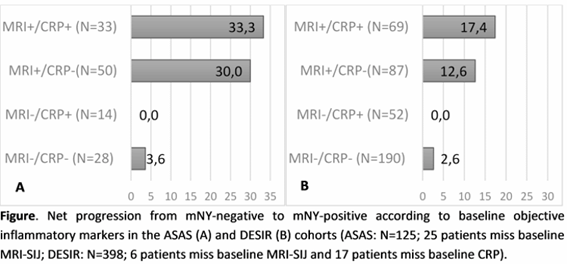Session Information
Date: Sunday, October 21, 2018
Session Type: ACR Poster Session A
Session Time: 9:00AM-11:00AM
Background/Purpose: The effect of MRI-detected inflammation on the development of radiographic damage at the sacroiliac joints (SIJ) level in patients (pts) with axial SpA (axSpA) has been previously shown when images were scored by trained central readers1. Central reading decreases measurement error, but does not translate easily to what is usually done in clinical practice. We aimed to test the possible effect of MRI-SIJ inflammation on structural damage in X-SIJ, when both are assessed by local readers as in daily clinical practice.
Methods: Pts with axSpA from both the ASAS and DESIR cohorts were included. MRI-SIJ and X-SIJ were obtained at baseline (BL), and X-SIJ at follow-up (ASAS: mean 4.4 years; DESIR: 5 years) and scored by local readers (rheumatologists/radiologists). Images were taken unblinded to other imaging information and clinical characteristics. Readers had the option to view the BL image when scoring the follow-up image. Bone Marrow Edema (BME) at MRI-SIJ was assessed either without a formal definition (ASAS) or according to the ASAS definition (DESIR). Structural damage in the X-SIJ was defined according to the mNY criteria. The % of structural net progression (number of ‘progressors’ minus the number of ‘regressors’ divided by the total number of pts) was assessed in subgroups according to CRP and BME status at BL. The effect of BME on MRI-SIJ on X-SIJ damage was evaluated in logistic regression models adjusted for potential confounders selected a priori on clinical grounds (gender, HLA-B27, CRP, symptom duration, variables available in both cohorts).
Results: In total, 125 (ASAS-cohort) and 415 (DESIR-cohort) pts had complete 5-year X-SIJ data available. Remarkably, but not unexpectedly, the % of ‘improvements in X-SIJ’ was impressive both in the ASAS and DESIR cohorts (8.8% and 5.5% respectively), yielding a total % of net progression that was higher in the former than in the latter (19.2% and 6.3%). Net progression in X-SIJ ranged from 0.0% to 33% and from 0% to 17.4% according to the presence of objective signs of inflammation at BL in the ASAS- and DESIR-cohorts, respectively (figure). In the multivariable analysis, the presence of baseline BME at MRI-SIJ both in the ASAS (OR=3.1 [95% CI: 1.3-7.9]), and DESIR cohorts (OR=7.4 [95% CI: 4.3-12.7]) was highly associated with X-SIJ structural progression at follow-up (table).
Conclusion: Our results, obtained in two independent cohorts, show that despite the expected increased ‘noise’ (measurement error) invoked by local reading, inflammation on MRI-SIJ still clearly associates with the development of radiographic damage in axSpA.


To cite this abstract in AMA style:
Sepriano A, Ramiro S, Landewé RBM, Dougados M, van der Heijde D, Rudwaleit M. Inflammation on MRI of the Sacroiliac Joints Is Highly Associated with Structural Damage in Axial Spondyloarthritis Patients in Clinical Practice: Data from the ASAS and DESIR Cohorts [abstract]. Arthritis Rheumatol. 2018; 70 (suppl 9). https://acrabstracts.org/abstract/inflammation-on-mri-of-the-sacroiliac-joints-is-highly-associated-with-structural-damage-in-axial-spondyloarthritis-patients-in-clinical-practice-data-from-the-asas-and-desir-cohorts/. Accessed .« Back to 2018 ACR/ARHP Annual Meeting
ACR Meeting Abstracts - https://acrabstracts.org/abstract/inflammation-on-mri-of-the-sacroiliac-joints-is-highly-associated-with-structural-damage-in-axial-spondyloarthritis-patients-in-clinical-practice-data-from-the-asas-and-desir-cohorts/
